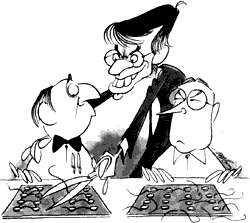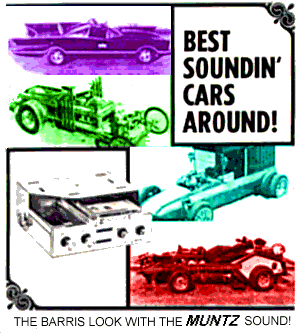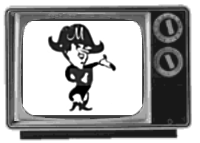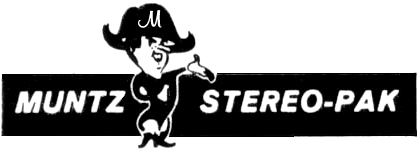What's All This Muntzing Stuff, Anyhow?
Recently, a young engineer wanted to
show me a circuit he had been optimizing. We reviewed the
schematic and the breadboard, and we studied the waveforms on the
'scope. We realized that one of the resistors was probably doing
more harm than good, so he reached over for a soldering iron. When
he turned back to the circuit, the offending resistor was gone!
How did it disappear so fast? Ah, I said, I always keep a pair of
small diagonal nippers in my shirt pocket. And when I want to
disconnect something, it only takes a second to snip it out or
disconnect it on one end - just like Earl "Madman" Muntz.
The kid looked at me. "Earl WHO?" And I explained.
Back in the late 1940s and early 1950s, television sets were
big and expensive and complicated -a whole armful of vacuum tubes,
lots of transformers and rheostats and adjustments that had to be
trimmed, and many complicated circuits for signal processing. And
all to drive a crummy little green-and-white 5-in. or 7-in.
picture tube, where the whole family could crowd around to watch.
Earl Muntz was a smart, flamboyant businessman. Anybody who
could make a success of selling used cars in 1939 or 1946 had to
know something about salesmanship, and Muntz had built up a $72
million business in Glendale, Calif.
For example, Muntz would advertise a particular car with a
special price as the "special of the day" - a car that had
to sell that day. If the car was not sold by the end of the day,
Muntz vowed to smash it to bits with a sledge-hammer, personally, on
camera. Needless to say, with tricks like that he was able to
generate a lot of publicity and interest, and sell a lot of old
cars, too.
So when Muntz started his plans to sell TV receivers in 1946,
it was obvious that he would be looking for a competitive
advantage - in other words, he had to have an angle. He wanted to
get the circuits simple - the manufacturing costs low - and he
knew he needed a lot of promotion.
He realized that a receiver designed for "far-fringe
reception" (40 or 50 miles out) had to have at least 3 or
preferably 4 Intermediate Frequency (IF) stages (with a pentode
for each stage, plus a transformer, 5 capacitors, and 3
resistors), and loops to hold the frequencies stable even when the
signals were very weak.
Muntz decided to relinquish that "fringe" business to
RCA and Zenith and other established manufacturers. Instead, HE
would design for Manhattan and other urban areas, where you could
look out your window and see the doggone transmitting antenna on
top of the Empire State Building, or equivalent.
HE knew he could get engineers to design television receivers
that would be very inexpensive, very simple, and would still work
quite satisfactorily in these strong-signal areas. Then he could
get away with two IF stages, and they would not need fancy
loops, and the tubes could all be biased up with cheap-and-dirty
biases.
As the circuits shrank, the power supply shrank. And as the
price shrank, his sales volume began to grow, leading to still
further economy of scale in manufacturing. Muntz dropped his
prices so fast, so low, that his competitors again accused him of
being a madman, cutting prices and competing unfairly.
When people watched Ed Sullivan or other pioneering programs of
the era on their tiny 7-in. screens, who came on at the end of the
hour to promote his new, low-priced 14-in. (diagonal measurement)
TV sets? Why, Earl "Madman" Muntz himself!
"You can have TV in your home tonight," he would say.
"Your living room is our showroom." And, wearing red
long johns and a Napoleon hat, he would vow, "I wanna give 'em
away, but Mrs. Muntz won't let me. She's crazy."
Muntz was a smart merchandiser, and he knew that his
competitors' jibes could be turned to work to his advantage. He
knew that his TVs were not built of cut-rate parts - in fact, his
receivers were carefully engineered to be at least as reliable as
the competitors' sets that cost twice as much - and they would
perform just as well, so long as you stayed in a strong-signal
area.
And how did Muntz get his circuits designed to be so
inexpensive? He had several smart design engineers. The story
around the industry was that he would wander around to an
engineer's workbench and ask, "How's your new circuit
coming?"
 After a short discussion, Earl would say, "But, you seem to
be over-engineering this - I don't think you need this
capacitor." He would reach out with his handy nippers
(insulated) that he always carried in his shirt-pocket, and snip
out the capacitor in question.
After a short discussion, Earl would say, "But, you seem to
be over-engineering this - I don't think you need this
capacitor." He would reach out with his handy nippers
(insulated) that he always carried in his shirt-pocket, and snip
out the capacitor in question.
Well, doggone, the picture was still there! Then he would study
the schematic some more, and SNIP... SNIP... SNIP. Muntz had made
a good guess of how to simplify and cheapen the circuit. Then,
usually, he would make one SNIP too many, and the picture or the
sound would stop working. He would concede to the designer,
"Well, I guess you have to put that last part back in,"
and he would walk away. THAT was "Muntzing" - the
ability to delete all parts not strictly essential for basic
operation. And Muntz took advantage of this story, to whatever
extent it may have been true, and he publicized his
"uncanny" ability to cut his costs - in yet more
televised advertisements.
For several years, Earl Muntz kept impressing his engineers to
build in only the circuits that were essential, and for those
years, his TV receivers were competitive and cost-effective. All
because of his "Muntzing," he would say in his ads. But
really, that was just one aspect of good sharp engineering. And of
course, he had to know where to start snipping. Although he was
not a degreed electrical engineer, he was a pretty smart
self-taught engineer, and his marketing and advertising campaigns
capitalized on the story: He knew how to engineer what people
needed - right down to a price.
For example, only in the last 10 years has Automatic Fine
Tuning become universally available on UHF as well as VHF tuners,
so that manual fine tuning is unnecessary. But as early as 1958,
Muntz TV bragged that there was no fine tuning on their best
receivers, on all 12 channels. Did Muntz build in AFT before his
time?? Heck, no - he just left out the fine tuning knob. The
tuners were all tuned up at the factory. Then if the tuning
drifted on a hot day, or the tuner components aged, you just had
to call in a serviceman to tweak it with a special screwdriver.
So, Muntz had the gall to leave out an important feature, and
then he bragged about the apparent simplicity! You can fool some
of the people some of the time ...
Muntz got rid of the Horizontal Hold AFC circuit to cut costs.
He got his engineers to use a straight Hold circuit, which
actually worked well under strong signal conditions and was easier
to troubleshoot than the temperamental AFC loops of the day. He
pioneered and took advantage of the Inter-carrier sound (Parker
System) so that audio tuning was automatic and no separate tuning
was needed. This was a necessity before he could drop the
fine-tuning knob ...
For some production adjustments, his test technicians would
clip a trim pot onto the circuit, twiddle it to get the alignment
just right, and then remove the pot and solder in a fixed resistor
of the required value. All very fine, AND inexpensive, but as the
carbon resistor aged, and the circuit aged, the TV receiver would
go "on the fritz." Then the TV repairman would have to
make a special trim, much more expensive than just tweaking a pot.
The repairmen were happy to get all this repeat business, but
eventually the customers figured out that a low initial cost was
not necessarily the best investment ...
Finally, as the TV receiver business matured, Muntz realized he
had sold all of the cheap sets he could, and he got out of the
manufacturing business. After a brief bout with bankruptcy in
1954, he got back in the business of selling TV and electronics,
"HiFi and Stereo," in a Los Angeles store, until his
death in 1987 at the age of 77. The store is still open, operated
by his family and heirs.
These are SAD days, because kids don't get a chance to build
their own TVs or radios or FM tuners. Heathkit used to make it
easy to build their kits. I myself built three Heathkits and a
Knightkit 10-W amplifier, as well as a couple other kits. And I
helped some of my friends when they were having trouble with their
Heathkits. NOT because I was an expert on circuits in those days
at MIT, because I was really pretty ignorant of electronics - I
was a struggling would-be physicist then, in Course 8. I just
thought this electronics stuff was kind of fun! But I was
interested because these kits were such interesting stuff.
These days, you can hardly buy a kit. Heathkit went out of the
kit business in January of 1992. The kits were more expensive than
the assembled circuits you could buy from any number of stores.
BUILD your own TV? How bizarre! The Japanese could build them,
with very high quality and very low cost, and even if you threw in
your own labor for free, a Heathkit cost more to buy!!
Let's go back to the scene where Mr. Muntz was trying to
justify which parts could be safely left out of the TV set. If he
snipped out a resistor that appeared to be unnecessary, but it was
actually needed for operation on low line voltage, or when the
frequencies shifted on a hot day, then I really believe Mr. Muntz
would not prevent the designer from justifying it on a real need
basis. But frivolous circuits - they were too expensive to
keep.
Now let me make some observations about adding features and
"frivolous" circuits, which is what I tend to support.
An example: If I design a new circuit with 8 new features, I may
argue to the marketing expert that these features will surely sell
lots of these parts to new markets.
He may ask, "Bob, which of those 8 features will make it
sell so well?" And, I'll admit, I have no way to guess
exactly which ones, but I believe that 2 or 3 of them will be very
popular. No matter how much he grills me, he can't shake me loose
from my ignorance - I really do not know which of the 8 added
features will make the basic chip a great seller.
BUT, things have changed from the days of Earl Muntz. Today, I
can add 5 transistor functions here, and 8 there, and 14 here, and
27 there, and altogether they will not add 2% to the area of the
chip, nor the cost, and they won't hurt the yield.
They may not even impact the test time all that much. They will
surely have no affect on reliability if I design them properly. In
Earl Muntz's day, though, NONE of these statements were true.
Things sure keep a-changing, don't they??!!
|
 After a short discussion, Earl would say, "But, you seem to
be over-engineering this - I don't think you need this
capacitor." He would reach out with his handy nippers
(insulated) that he always carried in his shirt-pocket, and snip
out the capacitor in question.
After a short discussion, Earl would say, "But, you seem to
be over-engineering this - I don't think you need this
capacitor." He would reach out with his handy nippers
(insulated) that he always carried in his shirt-pocket, and snip
out the capacitor in question.

 Muntz
went from cars to televisions (he named his daughter Tee Vee, although she
is usually known as Tina) and distinguished himself in this field both by
making a fortune and by skimping on components in order to keep his prices
low. Engineers of a certain age still refer to the practice of "Muntzing",
which means reducing something to the absolute minimum number of parts it
requires in order to run. Muntz was famous for walking up to his
engineer's workbenches and snipping out capacitors that he considered to
be "extra" (the Muntz of legend always carried a pair of
insulated nippers for just such occasions).
Muntz
went from cars to televisions (he named his daughter Tee Vee, although she
is usually known as Tina) and distinguished himself in this field both by
making a fortune and by skimping on components in order to keep his prices
low. Engineers of a certain age still refer to the practice of "Muntzing",
which means reducing something to the absolute minimum number of parts it
requires in order to run. Muntz was famous for walking up to his
engineer's workbenches and snipping out capacitors that he considered to
be "extra" (the Muntz of legend always carried a pair of
insulated nippers for just such occasions).
